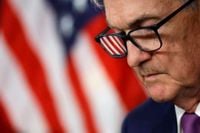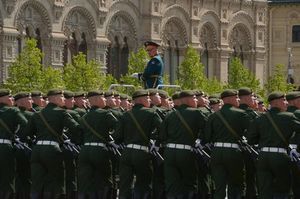WASHINGTON — The Federal Reserve on Wednesday held its key interest rate unchanged at a range between 4.25% and 4.5%, maintaining the same level it has been at since December. This decision comes amid rising uncertainty regarding the economic impact of President Trump's trade policies, particularly his tariffs, which have sparked concerns about inflation and growth.
The Federal Open Market Committee (FOMC) stated in its post-meeting announcement that "uncertainty about the economic outlook has increased further," highlighting the dual risks of rising unemployment and inflation. Fed Chair Jerome Powell, speaking at a news conference following the meeting, echoed this sentiment, noting that the current economic landscape is fraught with unpredictability.
"It’s really not at all clear what it is we should do," Powell remarked, reflecting the committee's cautious approach in light of the ongoing trade negotiations that began in early April. The White House is currently in talks with major trading partners, and while a 10% across-the-board tariff remains in effect, additional levies on steel, aluminum, and cars are also in place. Trump has even imposed a staggering 145% minimum tariff on certain Chinese goods.
Despite the turbulent backdrop, Powell asserted that the economy remains "in solid shape," with the labor market showing resilience. In April, the U.S. economy added 177,000 jobs, and the unemployment rate held steady at 4.2%. However, the first quarter of 2025 saw a contraction in the Gross Domestic Product (GDP), which fell by 0.3%, attributed largely to a surge in imports ahead of the tariff announcements.
The FOMC's statement underscored the complexities of the current economic situation, noting that "swings in net exports have affected the data," yet maintaining that economic activity continues to expand at a solid pace. Inflation, while currently at 2.3% overall and 2.6% when excluding food and energy, is being closely monitored as tariffs may lead to a temporary spike in prices.
Market reactions to the Fed's decision were mixed, with stocks initially wavering before recovering some ground. The Dow Jones Industrial Average saw gains of nearly 300 points, although concerns lingered regarding the Fed's characterization of economic risks. Analysts, including Krishna Guha from Evercore ISI, warned that the FOMC's statement suggests a looming trade shock could impact the economy significantly, complicating the Fed's efforts to balance its dual mandate of full employment and stable prices.
As the Fed navigates this uncertain terrain, market expectations for future rate cuts have shifted. Prior to the meeting, there was little anticipation of a cut this week, with only a 30% probability of a move in June. Now, traders are pricing in a total of three cuts this year, but the timeline remains fluid.
Powell emphasized that the Fed is not in a hurry to lower interest rates, stating that there is "no cost" in taking a more cautious approach. He acknowledged the challenges posed by Trump's tariffs and the potential for conflicting goals within the Fed's mandate. "It would be a difficult judgment if faced with that situation," Powell noted, indicating the committee's awareness of the delicate balance it must maintain.
Furthermore, Powell's remarks reflect a broader concern among Fed officials about the implications of Trump's policies on economic growth. As businesses express anxiety over supply chains and pricing due to tariffs, the Fed remains vigilant, prepared to respond should signs of economic weakening emerge.
While inflation expectations remain contained according to market-based measures, the Fed is wary of repeating past mistakes, such as underestimating the persistence of inflation following the pandemic. As a result, the bar for lowering interest rates has been set higher this time around.
In the backdrop of these developments, the political landscape adds another layer of complexity. Trump has publicly pressured Powell to implement rate cuts, labeling him "Mr. Too Late" for his reluctance to comply. This pressure has raised concerns among investors about the independence of the Federal Reserve, a cornerstone of U.S. economic stability.
The Fed's decision to hold rates steady reflects a commitment to a measured approach in the face of economic volatility. As Powell stated, the committee will continue to evaluate the economic landscape, particularly in relation to trade negotiations and their potential fallout. The next steps will depend heavily on how these tariffs and negotiations unfold in the coming months.
With the possibility of a trade truce looming, analysts are watching closely for any developments that could alter the economic outlook. Powell's cautious optimism and the Fed's steady hand will be crucial as the nation navigates this uncertain economic terrain.




